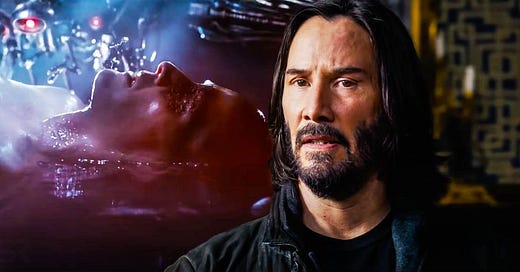The Matrix Resurrections
Though the epic sci-trilogy reboots after nearly 20 years in a clever start, it can't sustain the energy or verve of the original, ending up feeling rather tired and old.
Interesting experiences at the movies, just 15 hours apart: I saw “Spider-Man: No Way Home” on a recent night and after 45 minutes was thinking the movie was in serious trouble. But then it tied it all together in satisfying, slam-bang fashion.
The next morning “The Matrix Resurrections,” in contrast, had me hooked right from the beginning. How to reboot the watershed science fiction franchise after nearly two decades without it seeming stale or artificial? In a very clever, self-referential way, it turns out.
Alas, the movie can’t sustain the energy and verve of the daring original film or even its action-stacked sequel. It’s not quite as bad as the confusing, awful “The Matrix Revolutions,” but by the end it felt rather tired and old.
The story opens with Thomas Anderson (Keanu Reeves) living out a solitary, unsatisfying middle-age existence as a video game designer. His big hit 20 years ago was a trilogy of games called “The Matrix,” which, you guessed it, were exact retellings of the first three movies about a digital sham world run by computers to keep humans docile and imprisoned.
He sees an analyst (Neil Patrick Harris) who gives him therapy and meds to combat his delusions about being the god-savior of the Matrix, which at one point led to an unsuccessful suicide attempt. (They’re blue pills, of course.)
Thomas goes to the same coffee shop every day — Simulatte, har-har — to catch a glimpse of Trinity (Carrie-Anne Moss), herself drearily ensconced in marriage and motherhood, and renamed Tiffany. But he’s too meek to approach her.
And he feels hemmed in by his business partner, who is pushing him to make Matrix IV, something he swore never to do. But they’re forced to serve the whims of their parent company, Warner Bros., which just wants another money-maker, artistic merits be damned.
Good stuff, and I chortled.
There’s a hilarious montage where Thomas sits through endless idea pitch meetings as people blather about the “real” meaning of the Matrix — It’s about anti-capitalism! Bullet-time mayhem! Trans-politics! Gender roles! etc.
The barbs are clearly a little fun from Lana Wachowski, co-creator of “The Matrix” with sister Lilly Wachowski, then known as the Brothers. Lana directed and co-wrote the screenplay with David Mitchell and Aleksandar Hemon. Lilly is not involved in this movie.
I enjoyed all the self-referential tongue-in-cheek. But of course the movie has to get around to the business of gunfights, kung-fu, sunglasses-wearing agents, slinky metal sentinels and all the other cool stuff that made these movies iconic, which it soon does.
Some things have changed in the grimy real world, and in this sleek new edition of the Matrix. Landline phones are gone, so now the “operators” use mirrors, doors and other portals to move people in, out and about. They can also appear themselves as holograms.
The rebellious humans have joined forces with some nicer sentient machines, which look like metal bugs or birds. Helpful computer programs can also appear in the flesh, kinda, using magnetic metal beads to form an avatar of sorts.
The human city of Zion that was destroyed is replaced by Io, run by old friend Niobe (Jada Pinkett Smith), now turned into a bitter old general running the show who doesn’t want to take risks. And there’s an eye-pleasing new gang of young upstarts to help out, led by Bugs (Jessica Henwick), who like a lot of next-gen women idolizes Trinity.
If you’re wondering if other key figures show up, namely the dastardly runaway Agent Smith and wise seer/tutor Morpheus, the answer is of course they do… sort of. They’re now played by Jonathan Groff and Yahya Abdul-Mateen II, respectively, for reasons that are unclear.
(Hugo Weaving was busy and Laurence Fishburne wasn’t asked, according to press reports.)
Groff gives his Smith a sort of slinky sensuality that appeals, while Abdul-Mateen’s Morpheus, after some early charismatic scenes, is soon relegated to ‘generic helper guy’ role — a disappointing diminishment.
Once restored as his true self, Neo curiously appears to have seriously regressed in his powers. He can no longer fly, and agents that he was easily batting away likes flies now give him fits.
Perhaps it’s a commentary on aging or loss of artistic drive. I will say that both Reeves and Moss, though both aging quite beautifully, look decidedly slower and stiffer in their fight scenes, something that was also apparent in the last John Wick flick.
The middle section of the movie moves along with at a good clip, but somewhere around the 105-minute mark things begin to flag noticeably, and the movie hits a slog just as it should be gaining momentum. Despite the advances in CGI filmmaking, the stunts and visual effects feel more throwback than leap forward, like the 1999 film was.
“The Matrix Resurrections” starts out with a sense of freshness, or at least ironic puckishness, as it looks back on itself with a sense of time and weight. Neo spends a lot of the movie with imagery of the first films playing in the background, something intended to wrap it all together but that mostly serves as unfavorable comparison.






